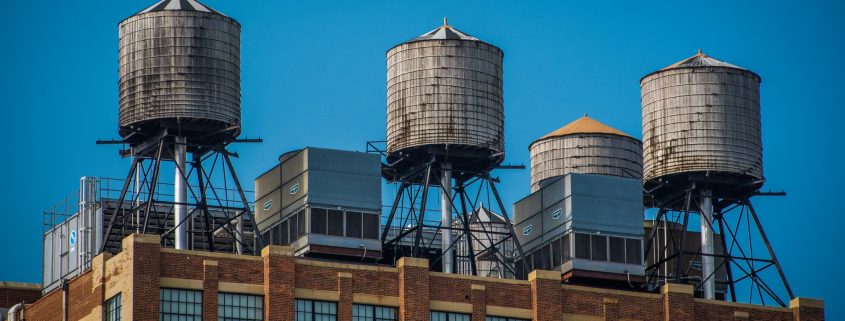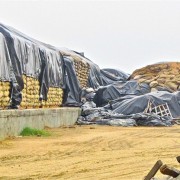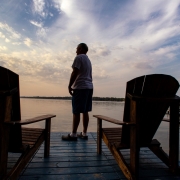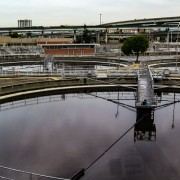Deadly Legionella Bacteria Are Common in U.S. Building Plumbing
Water samples from cooling towers across the country show signs of the bacteria.
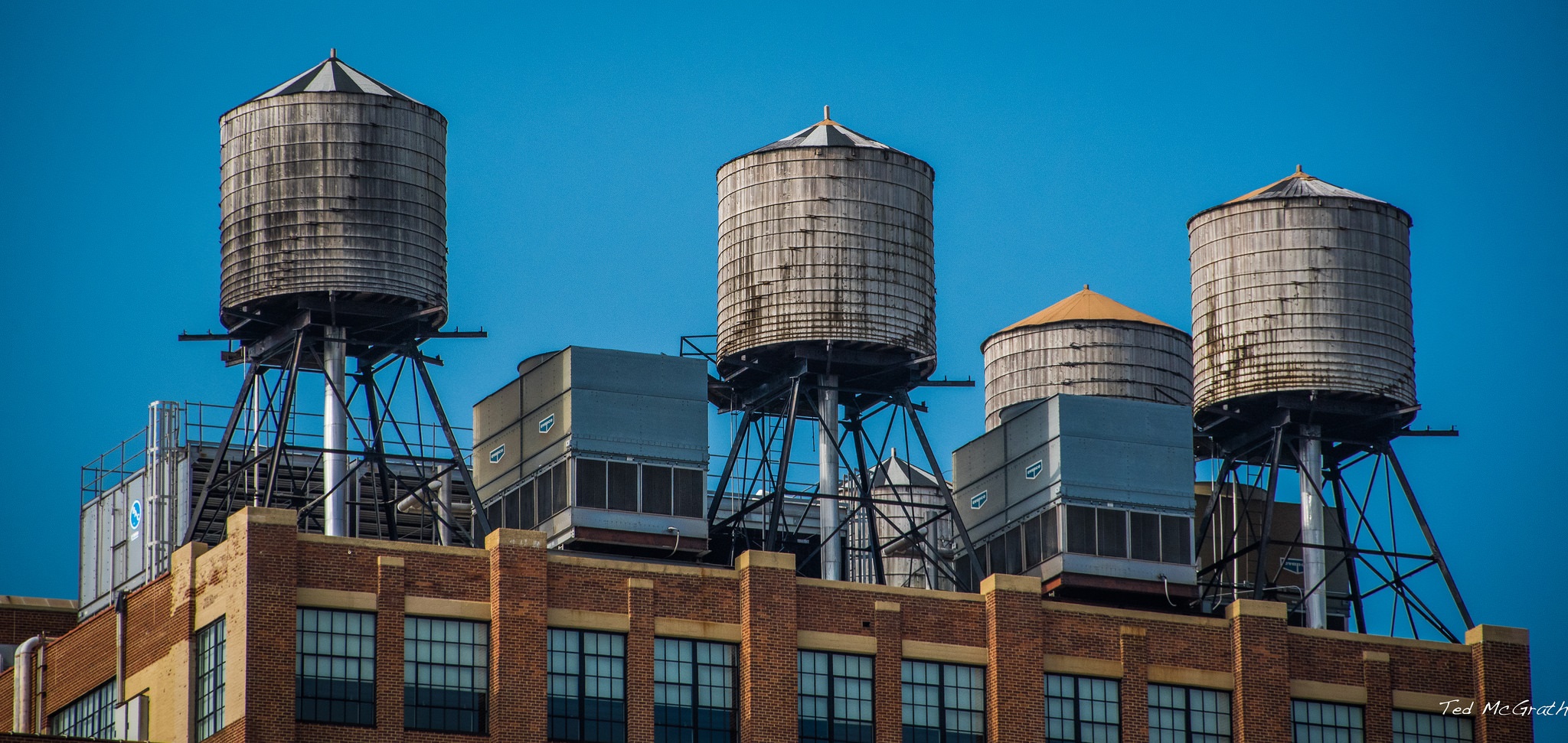
Rectangular cooling towers sit beneath water towers on top of a New York City building. Photo courtesy of Flickr/Creative Commons user Ted McGrath
By Brett Walton, Circle of Blue
Bacteria responsible for the deadliest waterborne disease in the United States are frequent residents of the cooling towers that are a part of heating and air conditioning systems in apartments, hospitals, nursing homes, hotels, and other large buildings, according to a study from the U.S. Centers for Disease Control and Prevention.
Legionnaires’ disease, the pneumonia-like illness spread by Legionella bacteria, sickens thousands annually in the United States and kills hundreds. Cooling towers, because they can disperse contaminated droplets over many miles, are implicated in numerous outbreaks of the disease.
It’s a scenario that should concern building managers throughout the country, the study authors argue.
“Finding the bacteria in all regions that we studied makes us aware that Legionella outbreaks are a possibility everywhere,” Brian Raphael, a CDC microbiologist and study co-author, told Circle of Blue.
The bacteria, which grow in warm waters in plumbing systems, target the lungs. Infection occurs when people inhale bacteria, having become airborne in the spray from a cooling tower, fountain, showerhead, or faucet. The ill and the elderly are most at risk — and that risk appears to be growing. Reported cases of Legionnaires’ disease have risen sharply, showing a four-fold increase in the United States since the year 2000, according to the CDC.
The study’s publication comes as the National Academy of Sciences begins an investigation next month of how to reduce the risk of Legionnaires’ disease and as a series of infections at a state-run veterans home in Illinois has brought the disease to the attention of the governor and one of the state’s U.S. senators.
Bacteria Are Common in Cooling Towers
The study posed a fundamental question: how widespread are Legionella bacteria in cooling towers? Despite the rising number of reported Legionnaires’ disease cases, Raphael said that basic data on the prevalence of the bacteria in cooling towers is missing. What researchers learn is usually what they discover when things go wrong.
“A lot of what we know is based on our investigations of outbreaks,” Raphael explained. An extensive outbreak in New York City in 2015 that was traced to a hotel cooling tower prompted the CDC to take a closer look at bacteria communities during everyday operations of building water systems.
The researchers analyzed water samples, collected as part of routine maintenance tests, from 196 cooling towers in the United States. The cooling towers were located in eight of the country’s nine climate regions, as defined by the National Oceanic and Atmospheric Administration. The only region not represented was the northern Great Plains.
The analysis, which was published in the journal PLOS One on December 20, proceeded in two stages. First, the researchers tested the samples for Legionella DNA. Six out of seven cooling towers tested positive.
DNA, however, is not the whole picture. Its presence is like a footprint, indicating that the bacteria had been there but not whether they are active. They could have been killed by disinfectant used to guard the water system against such pathogens.
Next, Raphael and his colleagues used a culture test to see if the bacteria were alive. Nearly half of the samples that were positive for DNA had Legionella bacteria that could be grown in a petri dish.
The results indicate that Legionnaires’ disease outbreaks can occur anywhere, according to Christopher Boyd, manager of building water health at NSF International, a body that sets industry standards.
“The CDC study helps dispel any myth that risks from cooling towers are isolated,” Boyd, who was not involved in the study, told Circle of Blue. “We see a broad segment of systems with viable Legionella that need to be addressed and managed.”
Boyd, who led the New York City Department of Health and Mental Hygiene’s response to the 2015 Legionella outbreak, said that the study supports the idea that building owners and managers need to think about disease prevention. Any place with a susceptible population is at risk of infection.
“These are preventable deaths,” he said.
How to do that is one of the goals of a National Academy of Sciences study that begins next month and is sponsored by the CDC, Environmental Protection Agency, Department of Veterans Affairs, and Alfred P. Sloan Foundation.
Known for its authoritative reports on matters of science and public policy, the Academy assembled an expert committee that includes university scholars, engineers, building managers, and public health officials.
Beginning February 8 with a meeting in Washington, D.C., the committee will evaluate strategies to inhibit the growth of Legionella in plumbing and cooling systems, such as the voluntary standards developed by industry groups NSF and ASHRAE. The committee will also consider policies that encourage those practices. The assessment is expected to take 18 months to complete.
There is much more work to do to understand Legionella, Raphael said. What microbe communities within cooling towers help or hinder Legionella growth? Can samples that test positive for Legionella DNA but do not grow in a culture still transmit the disease?
Perhaps most important is understanding why the number of reported cases has more than quadrupled in the last 15 years. Researchers point to a number of factors, including better diagnostic tests, an aging and sicker American public, poor building design, careless maintenance, or corroded water pipes that function as a bacterial breeding ground.
Brett writes about agriculture, energy, infrastructure, and the politics and economics of water in the United States. He also writes the Federal Water Tap, Circle of Blue’s weekly digest of U.S. government water news. He is the winner of two Society of Environmental Journalists reporting awards, one of the top honors in American environmental journalism: first place for explanatory reporting for a series on septic system pollution in the United States(2016) and third place for beat reporting in a small market (2014). He received the Sierra Club’s Distinguished Service Award in 2018. Brett lives in Seattle, where he hikes the mountains and bakes pies. Contact Brett Walton

